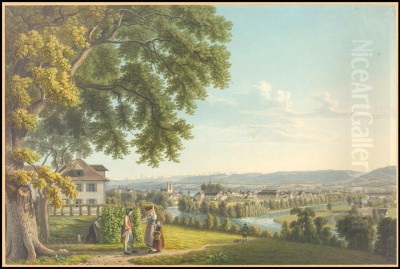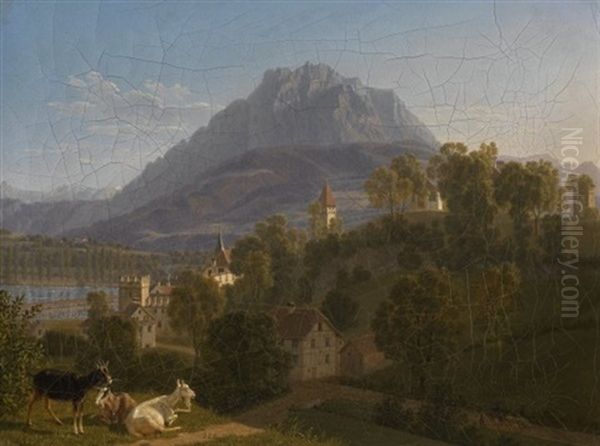
Johann Jakob Biedermann (1763–1830) stands as a significant figure in Swiss art history, a painter and etcher whose work captured the sublime beauty and pastoral charm of his homeland during a period of burgeoning Romantic sensibility and increasing tourism. Born in Winterthur, Switzerland, Biedermann dedicated his artistic life to depicting the landscapes, people, and specific locales of Switzerland, leaving behind a legacy of finely crafted paintings and widely circulated prints. His art bridges the detailed topographical tradition with emerging Romantic ideals, offering valuable insights into the Swiss environment and the artistic currents of the late 18th and early 19th centuries.
Early Life and Artistic Formation
Johann Jakob Biedermann's journey into the world of art began in Winterthur, a city with a growing cultural presence. His initial formal training was under the guidance of Johann Rudolf Schellenberg (1740–1806), a noted Swiss painter, etcher, and entomologist known for his detailed natural history illustrations and landscapes. This early exposure to Schellenberg's precision likely instilled in Biedermann a foundational respect for accuracy and close observation, traits that would remain evident throughout his career.
A pivotal moment in his development occurred in 1778 when Biedermann moved to Bern. There, he collaborated with Heinrich Rieter (1751–1818), another Swiss artist specializing in landscapes and portraits, often rendered in delicate watercolor. Working alongside Rieter allowed Biedermann to further hone his skills and deepen his understanding of Swiss topography. During this period in Bern, he also came under the influence of Johann Ludwig Aberli (1723–1786). Aberli was a master of the topographical landscape, particularly famous for his "Aberlische Manier," a technique involving outlined etching lightly filled with watercolor, which created highly detailed and popular views of Swiss scenery, catering to the growing tourist market. Aberli's success in capturing specific locations with accuracy undoubtedly shaped Biedermann's own approach to landscape.
Development of a Style: Precision and Romanticism

Biedermann's artistic style evolved into a distinctive blend of objective representation and subtle Romantic feeling. His works, whether in oil, watercolor, or etching, are characterized by a remarkable precision and clarity. He rendered mountains, lakes, trees, and architectural elements with meticulous detail, reflecting the topographical tradition inherited from artists like Aberli. This accuracy made his work appealing not only as art but also as faithful records of Swiss locations.
However, Biedermann was not merely a topographical draughtsman. His landscapes often transcend simple documentation, imbued with a sensitivity to atmosphere and light characteristic of the burgeoning Romantic movement. He frequently depicted scenes bathed in the soft light of late afternoon or evening, creating a mood of tranquility, nostalgia, or gentle melancholy. This emphasis on the atmospheric qualities and the emotional resonance of the natural world aligns him with the broader Romantic fascination with nature's power and beauty. While perhaps not as dramatically expressive as some of his German contemporaries like Caspar David Friedrich (1774–1840), Biedermann's work possesses a quiet romanticism rooted in the specific beauty of the Swiss environment.
Master of Swiss Landscapes
Switzerland's dramatic and picturesque scenery provided Biedermann with his primary subject matter. He traveled extensively within his home country, capturing its diverse landscapes with dedication. The Swiss Alps, serene lakes, rolling hills, and charming villages all found expression in his art. He was particularly drawn to the regions around Lake Lucerne, Lake Zurich, Lake Walen, and Lake Constance, areas renowned for their natural beauty.
His landscape paintings often include elements of human activity, integrating figures and animals into the natural setting. Genre scenes, depicting farmers at work, travelers resting, or locals engaged in daily life, add a narrative dimension and a sense of lived experience to his views. These figures are typically rendered with the same care and objectivity as the landscape itself, contributing to the overall harmony and realism of the composition. He avoided the heroic or overly idealized portrayals common in some Neoclassical landscapes, favoring instead a more grounded, observational approach reminiscent of Dutch 17th-century masters, albeit infused with a newer sensibility towards nature.
The Art of Etching and Printmaking
Beyond his paintings in oil and watercolor, Johann Jakob Biedermann was a highly accomplished etcher and printmaker. Recognizing the growing demand for affordable and transportable images of Switzerland, particularly among tourists undertaking the Grand Tour or its later variations, he produced numerous etchings. These prints often depicted specific towns, cities, and celebrated natural landmarks.
His etchings were known for their fine detail and technical skill. He mastered the medium to convey the textures of rock, foliage, water, and architecture effectively. Many of these prints were hand-colored, adding vibrancy and appeal. In 1802, Biedermann published a significant series of etchings focused on Swiss landscapes. This collection proved highly popular, circulating widely and contributing significantly to the visual representation of Switzerland both domestically and abroad. These prints played a crucial role in shaping the popular image of Switzerland as a land of breathtaking natural beauty, influencing how the country was perceived across Europe. His work in printmaking places him alongside other notable European landscape etchers of the era, such as the Dresden-based Swiss artist Adrian Zingg (1734–1816).
Travels and Teaching
Biedermann's career was not confined to one location. His travels were essential for gathering subject matter and likely for finding patrons and markets for his work. Records indicate he spent time in Zurich around 1782, a major cultural and artistic center. His presence in Bern in 1778 has already been noted. Later in his career, he continued to explore different regions.
In 1807, Biedermann took on a teaching role in Basel, instructing others in the art of painting. This position underscores his recognized skill and standing within the Swiss artistic community. His pedagogical activities would have allowed him to pass on his techniques and artistic vision to a younger generation.
Around 1814, he was particularly active in the area surrounding Lake Constance (Bodensee), a large lake bordering Switzerland, Germany, and Austria. This region, with its gentler landscapes compared to the high Alps, offered different motifs that likely featured in his work from this period. His final years saw him connected with Zurich, where he passed away in 1830, leaving behind a substantial body of work. A journey to Munich is also noted for 1830, the year of his death, suggesting he remained active until the end.
Representative Works
Several works exemplify Biedermann's style and thematic concerns:
_A Ploughman with His Horse, Lake Lucerne_: Often cited as a key work, this painting (or variations on this theme) captures a quintessential Biedermann scene. It typically depicts a pastoral landscape near Lake Lucerne, set against the backdrop of the Central Swiss Alps. The inclusion of a farmer with his horse emphasizes the harmonious relationship between humanity and nature, a common theme in his art. The detailed rendering of the figures, animals, and landscape, combined with atmospheric lighting, showcases his blend of realism and Romantic sensibility.
_Murg am Walensee_: This landscape painting depicts the area around Murg on the shores of Lake Walen (Walensee), a lake known for its dramatic fjord-like setting. Housed in the Kunstmuseum St. Gallen, this work likely highlights Biedermann's skill in capturing specific locations and varied Swiss terrains.
_Haus Scherers im Park_: A watercolor also held by the Kunstmuseum St. Gallen, this piece shows a specific building, the Scherers house, within a park setting in St. Gallen. It demonstrates his ability to work in watercolor and his attention to architectural detail within a natural environment.
_Bauernhaus in Kirchberg_ (Farmhouse in Kirchberg): Another work in the St. Gallen collection, this painting focuses on rural architecture, depicting a farmhouse in Kirchberg. It reflects his interest in the vernacular structures and everyday scenes of the Swiss countryside.
_Ansicht von Luzern_ (View of Lucerne): This hand-colored etching, measuring 50 x 77 cm and housed in the Kunstmuseum Luzern, is representative of his printmaking output. Such views of cities were popular souvenirs and important documents of urban landscapes before the advent of photography. Its size suggests it was intended as a significant display piece.
These examples illustrate the range of Biedermann's work, from broad landscapes and pastoral scenes to specific architectural studies and urban views, executed in various media including oil, watercolor, and etching.
Biedermann in Context: Contemporaries and Influence
Johann Jakob Biedermann worked during a dynamic period in European art. The late 18th and early 19th centuries witnessed the decline of Rococo, the dominance of Neoclassicism, and the rise of Romanticism. Landscape painting gained unprecedented importance during this time, evolving from a backdrop for historical or mythological scenes into a genre valued for its own expressive potential.
In Switzerland, Biedermann was part of a generation of artists exploring their native scenery with newfound appreciation. He followed in the footsteps of pioneers like Caspar Wolf (1735–1783), whose dramatic paintings of the Alps were groundbreaking. He was contemporary with figures like the poet-painter Salomon Gessner (1730–1788), known for his idyllic landscapes, and Sigmund Freudenberger (1745–1801), who focused more on genre scenes within Swiss settings. The leading Swiss portraitist of the era, Anton Graff (1736–1813), though primarily based in Dresden, maintained connections with his homeland.
Biedermann's detailed, often tranquil landscapes offer a contrast to the more turbulent or sublime visions of nature found in the work of British Romantics like J.M.W. Turner (1775–1851) or John Constable (1776–1837). His approach is perhaps closer in spirit, though different in style, to some German contemporaries who also focused on precise renderings of specific locales, such as certain aspects of the work of Philipp Hackert (1737-1807), a German Neoclassical landscapist highly successful in Italy. While lacking the overt spiritual or symbolic depth of Caspar David Friedrich, Biedermann shared the Romantic era's deep engagement with the natural world. His meticulousness also connects him to a lineage of Northern European landscape tradition, valuing observation and detail. His work can also be seen in dialogue with the classical landscape ideals derived from artists like Claude Lorrain (1600-1682) and Nicolas Poussin (1594-1665), whose compositional structures often influenced later landscapists, even those leaning towards Romanticism. Furthermore, the philosophical currents of the time, including the ideas of Jean-Jacques Rousseau (1712-1778) emphasizing nature's purity and importance, created a receptive climate for landscape art like Biedermann's. Another important contemporary landscapist working in the Alps and Italy was Joseph Anton Koch (1768–1839), whose heroic landscapes offer another point of comparison.
Biedermann's influence extended primarily through his popular prints, which helped define the visual identity of Switzerland for a generation. His paintings, while perhaps less internationally renowned than some contemporaries, hold an important place in Swiss national art history. They represent a significant contribution to the landscape genre, capturing the specific character of the Swiss environment with skill and sensitivity.
Legacy and Conclusion
Johann Jakob Biedermann died in Zurich in 1830, concluding a career dedicated to the art of landscape and printmaking. He successfully navigated the artistic transitions of his time, blending the precision demanded by the topographical tradition with the emerging Romantic appreciation for nature's atmospheric and emotional qualities. His work provided viewers, both contemporary and modern, with meticulously observed and aesthetically pleasing visions of Switzerland.
His paintings, preserved in Swiss museums like those in St. Gallen and Lucerne, as well as in private collections, stand as testaments to his skill as a painter in oil and watercolor. His numerous etchings, often hand-colored, played a vital role in the burgeoning tourist industry and the dissemination of Swiss imagery. They remain valuable historical documents and charming examples of late 18th and early 19th-century printmaking.
Johann Jakob Biedermann's legacy lies in his contribution to Swiss landscape painting and printmaking. He was a careful observer, a skilled technician, and an artist sensitive to the beauty of his native land. His works offer a window into Switzerland's past, capturing its natural splendors and pastoral life with enduring clarity and charm, securing his position as a respected master within the rich tapestry of Swiss art history.